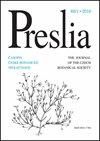Do ploidy level, morphology, habitat and genetic relationships in Alpine Vaccinium uliginosum allow for the discrimination of two entities?
IF 4.4
2区 生物学
Q1 PLANT SCIENCES
引用次数: 9
Abstract
Evolutionary processes such as recurrent origin of polyploids and enhanced gene flow among polyploids make polyploid complexes taxonomically highly intricate. One such complex is the mostly diploid and tetraploid cloudberries (Vaccinium uliginosum L. s.l.), which are not only one of the most frequently recorded dwarf shrubs in the Arctic, but also in mountain ranges such as the European Alps. Surprisingly, in spite of its ubiquity there is very little information on variation in ploidy level, habitat and morphology of V. uliginosum s.l. across the Alps and in adjacent areas; also the taxonomic status of V. uliginosum s. str. and V. gaultherioides is controversial. Based on five latitudinal transects sampled across the middle Alpine arc and an integrative approach combining flow cytometry, plastid DNA sequencing, amplified fragment length polymorphism fingerprinting, morphometrics and characterization of ecological niches via phytosociology and Landolt indicator values the following questions were addressed: (i) What is the large-scale distribution of diploid and tetraploid V. uliginosum s.l. in the area sampled? (ii) Are molecular genetic relationships governed by ploidy level differentiation or is there evidence for acrosscytotype gene flow causing geography-correlated clustering? Is there evidence for (iii) ecological or (iv) morphological separation between cytotypes? We revealed that tetraploids occur throughout the area investigated in the Alps and in their northern forelands, whereas diploids appear to be restricted to the Central Alps and the Southern Limestone Alps. The two cytotypes corresponded to two non-overlapping groups in the AFLP data set, and were also in almost perfect congruence with two plastid lineages. The single evidence for gene flow between diploids and tetraploids was a tetraploid individual carrying a haplotype from an otherwise exclusively diploid lineage. Diploids and tetraploids show some degree of niche separation, which is mostly due to the exclusive occurrence of tetraploids at low altitudes; above 1500 m a.s.l. both cytotypes co-occur. Accordingly, tetraploids occur in a broader range of plant communities than diploids. In spite of the clear separation of diploids and tetraploids in the molecular data sets we failed to detect consistent morphological differences. In particular, absolute size characters exhibited a strong inverse correlation with altitude within the tetraploid cytotype, which prevents their use for reliable determination. Consequently, based on the characters employed here, it is currently impossible to morphologically discriminate diploid V. gaultherioides and tetraploid V. uliginosum s. str. in areas where their ranges overlap, i.e. in subalpine and alpine dwarf shrub communities.高山牛苗的倍性水平、形态、生境和遗传关系是否允许两种实体的区分?
多倍体的反复起源和多倍体间基因流动的增强等进化过程使得多倍体复合体在分类学上高度复杂。其中一个复合体是主要是二倍体和四倍体的云莓(Vaccinium uliginosum l.s.l .),它不仅是北极地区最常见的矮灌木之一,而且在欧洲阿尔卑斯山等山脉也有记录。令人惊讶的是,尽管它无处不在,但关于其倍性水平、栖息地和形态在阿尔卑斯山及其邻近地区的变化的信息却很少;此外,在分类地位上也存在争议。基于在阿尔卑斯中部弧线取样的5个纬度样带,结合流式细胞术、质体DNA测序、扩增片段长度多态性指纹图谱、形态计量学以及植物社会学和Landolt指标值对生态位的表征,研究了以下问题:(1)二倍体和四倍体乌里金沙菌在采样地区的大规模分布是什么?(ii)分子遗传关系是否受倍性水平分化的支配,或者是否有证据表明跨细胞型基因流动导致地理相关的聚类?是否有证据表明细胞类型之间存在(iii)生态或(iv)形态分离?我们发现,四倍体在阿尔卑斯山及其北部前陆的整个调查区域都有,而二倍体似乎仅限于阿尔卑斯中部和南石灰岩阿尔卑斯。这两种细胞型对应于AFLP数据集中的两个非重叠组,并且与两个质体谱系几乎完全一致。二倍体和四倍体之间基因流动的唯一证据是,一个四倍体个体携带来自二倍体谱系的单倍体。二倍体和四倍体表现出一定程度的生态位分离,这主要是由于四倍体在低海拔地区只存在;在海拔1500米以上,两种细胞型同时发生。因此,四倍体比二倍体在更广泛的植物群落中出现。尽管在分子数据集中二倍体和四倍体有明确的分离,但我们未能检测到一致的形态差异。特别是,在四倍体细胞型中,绝对大小性状与海拔高度呈强烈的负相关,这妨碍了它们的可靠测定。因此,基于本文所采用的性状,目前还不可能在其分布范围重叠的地区,即亚高山和高山矮灌木群落中,从形态上区分二倍体高卢菌和四倍体乌利木菌。
本文章由计算机程序翻译,如有差异,请以英文原文为准。
求助全文
约1分钟内获得全文
求助全文
来源期刊

Preslia
生物-植物科学
CiteScore
5.20
自引率
29.40%
发文量
8
审稿时长
>12 weeks
期刊介绍:
Preslia is a peer-reviewed scientific journal publishing original research papers on plant systematics, morphology, phytogeography, ecology and vegetation science, with a geographical focus on central Europe. The journal was founded in 1914 and named in honour of brothers Jan Svatopluk Presl (1791–1849) and Karel Bořivoj Presl (1794–1852), outstanding Bohemian botanists. It is published quarterly by the Czech Botanical Society.
 求助内容:
求助内容: 应助结果提醒方式:
应助结果提醒方式:


